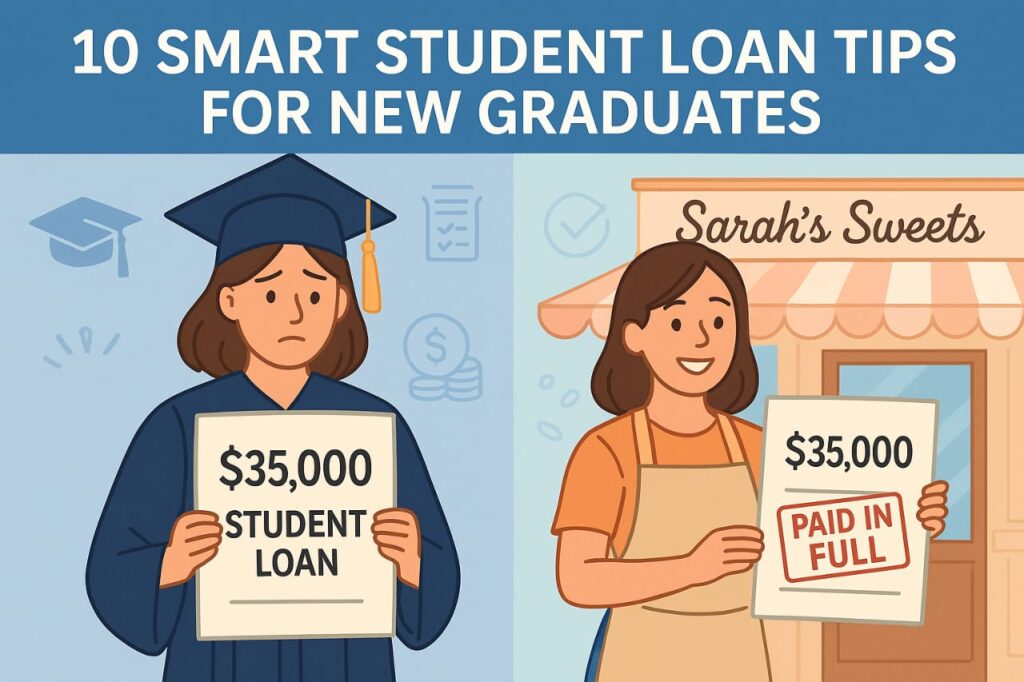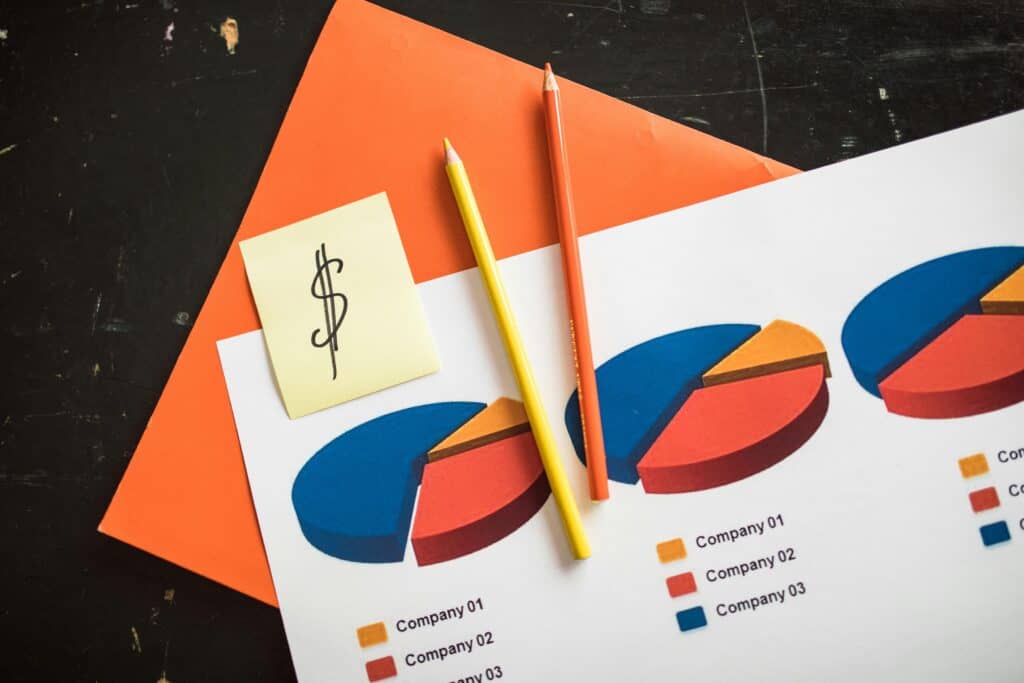
Graduation is all about celebration, diplomas, tassels, and selfies! But it’s also a time when the reality check of student loans comes in. 45 million people in the USA live with $1.6 trillion in student loan debt (Federal Student Aid, 2025). Feeling overwhelmed? Don’t worry; you’re not alone!
Meet Sarah, a recent grad who managed her $35,000 loan with smart planning and is now planning to start her dream bakery. In this guide, we’ll share 10 student loan management tips for graduates that will help you reduce stress, save money, and build a financially secure future. Ready? Let’s get started!

1️⃣: Know Your Loans: Federal vs Private
Before making a payment, it is essential to determine the type of loan you have. The repayment rules, interest rates, and benefits of each loan type are different.
The first piece of advice for managing student loans is to properly identify the type of loan:
federal or private.
Federal Loans
- What are federal loans? Federal loans are loans issued by the government.
- Include Direct Subsidized, Unsubsidized, and loans
- Link to income-driven repayment (IDR), deferment, forbearance, and forgiveness plans.
Private Loans
- From banks or private lenders
- Typically higher interest rates
- Limited flexibility in repayment
- Not eligible for federal forgiveness programs
Log in to studentloans.gov to view complete details of your federal loan. For private loans, contact your lender directly.
2️⃣: Understand Your Grace Period
Most federal loans offer a grace period of 6 months after graduation.
And you don’t need to make payments during this time. But don’t waste it:
- Prepare your budget
- If possible, just start paying the interest
- Understand the options for repayment plans
In private loans, the grace period may differ or not be available at all; please confirm.
3️⃣: Choose the Right Repayment Plan

One of the most important student loan management tips for graduates is to choose the right repayment plan. Forbes.com
Standard Repayment Plan
- Fixed payments for 10 years
- Lowest total interest
Graduated Repayment Plan
- Small payments at first, then gradually increase as per the rules
- If your income is going to increase, then this is the best option
Extended Repayment Plan
- There will be fixed or graduated payments for 25 years.
- The monthly payment will be less, but the total interest will be high.
Income-Driven Repayment Plans (IDR)
There are only 3 IDR plans available to apply for in 2025.
- IBR – Income-Based Repayment
- PAYE – Pay As You Earn
- ICR – Income Contingent Repayment
The court halted the SAVE Plan (formerly known as REPAYE) in February 2025, and as a result, you cannot currently apply for this plan.
Summary
| Plan | Monthly Payments | Loan forgiveness | Note |
|---|---|---|---|
| IBR | 10–15% of income | After 20–25 years | Reliable plan, best option for frequent borrowers |
| PAYE | 10% of income | After 20 years | Only a few people qualify (specific date requirements) |
| ICR | 20% or 12-year plan | After 25 years | More payment is possible, but it is good as a fallback option |
⚠️ Important Points (2025 changes):
The SAVE Plan is no longer available for new applications. Only IBR, PAYE, and ICR are now open to apply. Recertification (re-verify income) delayed till Feb 2026. For married borrowers: Now spouse’s income is not included if you file taxes separately.
4️⃣: Set Up Autopay and Stay Organized

It has two main advantages: firstly, payment is not late through Autopay, and secondly, you also get an interest discount of 0.25%.
Organisation Tips:
Create a digital folder for loan documents
Set reminders in the calendar or an app
If you haven’t started payment yet, keep track of how much the interest is increasing.
Recommended Apps:
Mint
YNAB
Student Loan Hero
Personal Experience:
A user on X (@GradLife2025) shared that using YNAB, he saved $500 in interest by staying organised!
Quick Action: Set up autopay today and try YNAB or Mint.
5️⃣: Pay Extra When You Can
If you contribute a bit more, then:
- The loan will be settled faster.
- You will save significantly on interest.
- Your credit score will also improve.
Extra Tip: When making an additional payment,
Inform the servicer to apply the funds to the principal rather than the upcoming payment.
Two Popular Strategies: - Debt Snowball: Clear the smallest loans first. Debt Avalanche: Focus on the highest interest first (more profitable)
“A couple reduced $130,000 of student loans through budgeting and side hustles.
Now he only has $49,015 left or maybe even less (Six Figures Under). You too should try debt snowball or avalanche!”
6️⃣ Explore Forgiveness & Assistance Programs

Repaying your student loan isn’t the only wise choice; loan forgiveness and assistance programmes can also be beneficial. Don’t overlook these important opportunities that you might qualify for!
According to Federal Student Aid 2024 data, 1.2 million borrowers applied for PSLF, and 35% received a waiver, with an average waiver of $40,000.
Source: Federal Student Aid – PSLF Data
One example is a public school teacher who got $45,000 forgiven after working in a low-income school for 10 years. (Federal Student Aid)
1. Public Service Loan Forgiveness (PSLF)
If you are employed by the government or a qualifying nonprofit organization, this program could be ideal for you.
Basic Requirements:
You are required to make 120 timely monthly payments on your federal student loan (approximately 10 years).
You need to be employed full-time with an approved public service employer.
You must be enrolled in an Income-Driven Repayment (IDR) plan.
Tip: Remember to submit the PSLF employment certification form annually to maintain a clear record.
2. Teacher Loan Forgiveness
If you are a full-time teacher in a low-income school, you can get a loan waiver of anywhere from $5,000 to $17,500.
Who is eligible?
You must have taught at the same school for at least 5 consecutive years.
The school must fall under the federal category of low-income schools.
The $17,500 is for teachers who teach math, science, or special education.
Up to $5,000 is waived for other subjects.
3. Employer Student Loan Repayment Assistance
Numerous private companies are currently assisting their employees in repaying student loans. Make sure to take advantage of this!
How does it work?
Some companies can contribute up to $5,250 each year towards your student loan.
This amount is tax-free until 2025, meaning you will not have to pay income tax on it.
This benefit is more common in fields like IT, healthcare, and finance.
Tip: Be sure to ask your HR if your company offers this or not.
4. State-Based Loan Forgiveness Programs
Every state offers its students loan assistance or forgiveness initiatives, particularly for individuals who are:
Medical professionals, including doctors, nurses, or healthcare workers
Teachers, especially in rural or shortage areas
Lawyers who do public interest or legal aid services
Example:
California: loan repayment program for mental health workers
Texas: special loan relief for rural area doctors
New York: repayment assistance for public lawyers
Action Step: Check your state’s official education website search:
“student loan forgiveness program [state name]”
7️⃣: Avoid Common Mistakes That Cost You

Some mistakes in the beginning can cost you dearly in the future. Avoid these mistakes:
🚫 Missing payments
Your credit score may suffer
Increased risk of default
🚫 Not providing updated information to the loan servicer
Emails or notices get missed
🚫 Thinking that “I can’t afford it”
Income-driven plans: payments can be as low as $0
Exploring options is better than delaying
🚫 Falling prey to scams
No legitimate loan forgiveness service requires payment
Official assistance is exclusively available at studentloans.gov
This article presents the case of a borrower who took a $26,000 loan from a for-profit college and had difficulty making repayment because of an abusive situation. ECMC (loan servicer) ignored his pleas, despite court documents. This is a warning against scams and mismanagement.
Source: Saving for College – Student Loan Horror Stories
8️⃣: Consider Refinancing (But Cautiously)

When is refinancing right?
Your income is stable, and your credit score is good
You want to reduce interest rates
You do not depend on federal protection (PSLF, IDR)
Example:
As an illustration, NerdWallet showed a borrower who refinanced with SoFi from 7% to 5% interest on a $30,000 loan and saved $3,000 over ten years.
These refinancing options certainly have their benefits. If you happen to be interested in it, make sure to take advantage of these savings options.
Source: NerdWallet – Student Loan Refinancing Guide
❌ When to avoid refinancing:
You want flexibility in the future
You are working in nonprofit/public service
The financial future is uncertain
The financial future is uncertain
⚠️Refinancing converts federal loans into private loans, and you are not eligible for forgiveness or flexible plans.
9️⃣: Balance Loan Payments with Other Goals

Just because you have student loan debt does not mean you cannot save, invest, or enjoy life
🔹 Emergency Fund
- 3–6 months of backup is a must
- Build this alongside your loan
🔹 Retirement Saving
- Don’t forget to take the employer’s 401(k) match
- A Roth IRA is a good choice for beginners. Visit Vanguard.com
🔹 Budgeting
- You want to follow the 50/30/20 rule
- 50% need
- 30% want
- 20% savings/loan
🔟: Use Tools & Resources
Although life is very difficult, if you want, you can make your life easier by using these tools.
8🛠 Loans Tool’s
Studentaid.gov— Estimate your monthly payments and find the right repayment plan.
Loan Servicer Dashboards
(like Navient and MOHELA) View the details of your loan, payment history, and updates.
📚 Helpful Content
This knowledge will prove to be invaluable throughout your professional journey.
The College Investor – Expert advice on student loans, investing, and side hustles.
Student Loan Planner – Personalized strategies that work best for your situation.
NerdWallet – Trusted tips & comparisons to make financial decisions simple.
🎧Podcast and finance discussion
“So Money” by Farnoosh Torabi – Real-world stories & pro advice on managing money wisely.
“Afford Anything” by Paula Pant – You can’t afford everything, but what matters? This podcast reveals!
Graduates who use these tools in a consistent way find that their repayment journey is smooth and stress-free.
Conclusion: Your Financial Future Starts Now
At first glance, dealing with student loans may feel overwhelming, but with a suitable plan, you are in control. Whether your plan is the correct repayment plan, avoiding common mistakes, or even beginning some savings, every little action is a step forward.
If today’s graduate wants to take their journey seriously, these updated student loan management tips for graduates serve as a roadmap.
Just remember:
You don’t have to be loan-free tomorrow, but you have to be purposeful today.

Pingback: Want to Save Money Fast? Start With These Tiny Shifts